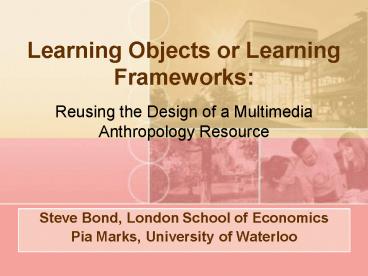Learning Objects or Learning Frameworks: - PowerPoint PPT Presentation
Title:
Learning Objects or Learning Frameworks:
Description:
'The essential benefit of learning objects is their capacity for ... 'For some time now there has been a growing awareness that ... The JORUM hybrid model ... – PowerPoint PPT presentation
Number of Views:43
Avg rating:3.0/5.0
Title: Learning Objects or Learning Frameworks:
1
Learning Objects or Learning Frameworks
Reusing the Design of a Multimedia Anthropology
Resource
- Steve Bond, London School of Economics
- Pia Marks, University of Waterloo
2
Overview
- Reuse
- the promise vs. the reality
- Repurposing vs. reuse
- a better approach?
- Whats Going On?
- The LSE/UW experience
3
Reuse the promise
- The essential benefit of learning objects is
their capacity for reuse, leading to reduction in
production costs (Oliver McLoughlin, 2003,
p.95)
- development costs
- instructor time
4
Reuse the reality
- For some time now there has been a growing
awareness that even the most accessible resources
have failed to be widely adopted by the
educational community and as a result have also
failed to fulfill their considerable educational
potential (Campbell, 2003, p.35)
Uptake of these resources is happening at a
slower than desirable pace, despite the
unquestionable quality of design and production,
high levels of investment in professional
development and the rationally anticipated
outcome of this investment (Gunn, Woodgate
OGrady, 2005, p.189).
5
Why the gap between promise and reality?
- Problems with reuse identified in the
literature - Inflexibility of resources
- Technical problems
- Time
- Cultural factors
- Educational factors
6
Repurposing vs. Reuse
- Gunn, Woodgate OGrady (2005) propose a
participative repurposing design model - defined as a process where the original
structure of a learning object is populated with
content from a different source and/or subject
area and used to develop new learning activities
(p.191). - involves working collaboratively with the
structure of an existing object, populating it
with familiar content and embedding it within
self-defined learning activities (p.195).
7
Whats Going On?
- Video-interpretation tool developed at LSE
- First-year undergrad. ethnography module
- Gorilla Thrilla the Mbendjele hunters tale
- Level 1 3 months' fieldwork / 150 words
- Level 2 9 months' fieldwork / 300 words
- Level 3 18 months' fieldwork / 600 words
- Exercise completed over 2 weeks
- Students also read full ethnography
8
Repurposability of WGO
- WGO fully customisable
- Can be used in new teaching contexts
Tool
9
The UW version
- How was it modified?
- New video
- Different focus (from linguistic to visual
interpretation) - Info links contained summarized content vs.
journal articles - What stayed the same?
- The structure of the activity
- Level 1 (150-300 words)
- Level 2 (300 words)
- Level 3 (400 words)
10
UW outcomes
- Student evaluation
- Majority of students claimed that the exercise
helped them learn about ethnography/how to
analyze ethnographic data and engage with the
subject matter - Lessons learned
- Successful customization, with the following
caveats - Students require encouragement to take
intellectual risks by making their own
interpretations rather than relying on supplied
textual data - Use of full research articles vs. summaries
should help - Students need help in analyzing and interpreting
visual data more instructor scaffolding required
11
Advantages of a repurposing approach
- addresses the inflexibility issues
- content and context are separated
- addresses the educational issues
- results in a sense of ownership, acceptance and
ability to realize the potential of technology in
different contexts (Gunn, Woodgate OGrady,
2005, p.190.) - addresses the reuse issue
- Gives the instructor confidence to use the
learning object in a variety of situations
12
Unresolved issues
- Cultural factors
- Incentives to invest in teaching still dont
exist rewards/recognition for teaching remain a
barrier to reuse and repurposing - A credible reward system needs to be established
by senior academic administrators - Time factor
- Repurposing requires a time commitment from the
instructor which, if not supported by
institutional culture, will remain problematical - WGO A new authoring suite is available for
customizing the toolhttp//clt011.lse.ac.uk8383/
steve/wgo/authoring/
13
References
- Campbell, L. (2003). Engaging with the learning
object economy. In A. Littlejohn (Ed.), Reusing
Online Resources A Sustainable Approach to
e-learning (p. 35-45). London Kogan Page
Limited. - Gunn, C., Woodgate, S. OGrady, W. (2005,
October). Repurposing learning objects a
sustainable alternative? ALT-J, 13(3), 189-200. - Koppi, T., Bogle, L. Lavitt, N. (2004).
Institutional use of learning objects Lessons
learned and future directions. J Educational
Multimedia and Hypermedia, 13(4),449-463. - Littlejohn, A. (2003). Issues in reusing online
resources. In A. Littlejohn (Ed.), Reusing Online
Resources A Sustainable Approach to e-learning
(pp.1-6) London Kogan Page Limited.
14
References
- McNaught, C. (2003). Identifying the complexity
of factors in the sharing and reuse of resources.
In A. Littlejohn (Ed.), Reusing Online Resources
A Sustainable Approach to e-learning (pp.
199-211). London Kogan Page Limited. - Metros, S.E. (2005, July/August). Learning
Objects A Rose by Any Other Name. EDUCAUSE
Review, 12-13. - Oliver, R. McLoughlin, C. (2003). Pedagogical
designs for scalable and sustainable online
learning. In A. Littlejohn (Ed.), Reusing Online
Resources A Sustainable Approach to e-learning
(pp.94-105). London Kogan Page Limited. - Zemsky, R. Massy W.F. (2004). Thwarted
Innovation What Happened to E-Learning and Why.
Final Report for The Weatherstation Project,
University of Pennsylvania The Learning
Alliance. Retrieved on July 10 2006, from
http//www.irhe.upenn.edu/WeatherStation.html
15
Contact details
- Steve Bond s.bond1_at_lse.ac.uk
- Pia Marks pia_at_LT3.uwaterloo.ca
- LSE DART project
- http//www.lse.ac.uk/collections/anthropology/dart
.htm - University of Waterloo LT3 Centre
- http//lt3.uwaterloo.ca/































